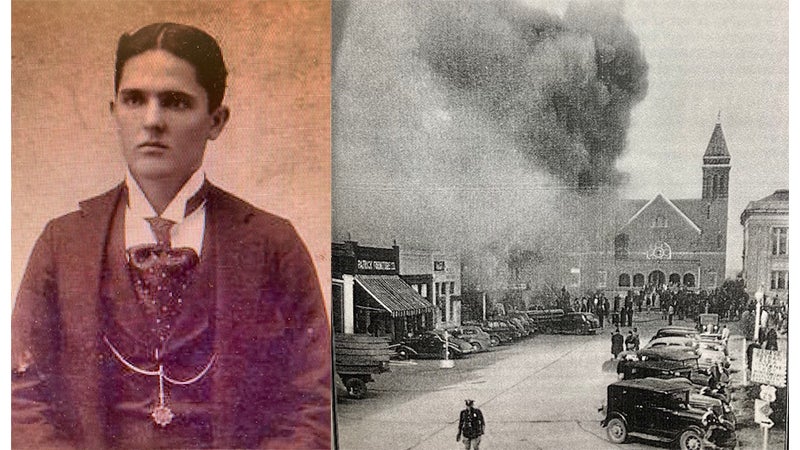REMEMBER WHEN: Pioneer in the theater business
Published 2:00 pm Friday, June 9, 2023

- LEFT: Z. D. Studstill, pioneer of Andalusia movie houses RIGHT: "January 5, 1940 - Fire destroys the Paramount Theater in downtown Andalusia. People looked for refuge by gathering on the front steps and entryway of the old First Baptist Church and on the west side steps of the Covington County Courthouse. It is remembered that school turned out so the children could view the fire." (PHOTOS PROVIDED)
|
Getting your Trinity Audio player ready...
|
From the early beginnings of the town Andalusia in the 1840s when the residents of Montezuma on the banks of the Conecuh River moved up the hill to higher ground, there has always been a love for entertainment after hard work. It didn’t take long for an Opera House to be built downtown. Traveling shows came to town as were advertised in the old newspapers – songsters, dancers, magicians, jugglers, and comedians. Saturday afternoon matinees for the ladies were often presented and well attended.
By around 1920, the first motion picture (silent movies) opened in the old Opera House by a businessman who has become known as the “pioneer in the movie business” in Andalusia, Mr. Z. D. (Zachariah Daniel) Studstill. Sometime later, the picture show moved to the Prestwood building and afterwards to the Fox Theatre on East Three Notch Street in a building adjacent to WAAO where a parking lot is now located at the corner of Central Street and Three Notch.
Mr. Sidney Waits recalled wooden folding chairs being in the Fox movie house and a Mrs. Prestwood who played the piano for the silent movie shows.
The Studstill family moved to Andalusia in 1901 from Brantley where he worked as agent for the new Central of Georgia Railroad Company. He interested himself in all that pertained to the growth and development of Andalusia. Studstill served as a City Clerk in the Mayor Henry Opp administration and as a City Councilman in the Mayor Trammell Henderson administration. In 1906 he became mayor of Andalusia for a five-year term.
It was reported in The Andalusia Star in the 1930s that “Studstill was a man of pleasing personality among his wide circle of friends and a highly esteemed businessman, expert accountant who kept a close tab on his business.”
Headlines in the September 9, 1930 Andalusia Star read, “STUDSTILL HAS DEVELOPED FINE THEATERS HERE – Operated so as to please fully its varied patronage in this section, and showing the best of productions that the modern movie world has to offer the public, the Studstill Theaters located in Andalusia, Brantley, and Opp take a large and interesting part in the community life by furnishing wholesome entertainment for the public.”
Studstill entered the theater business around 1920 (maybe a little bit before World War I) at the Royal built in “the bottom” (South Cotton Street) where Sullivan’s Furniture was later located. He opened another Royal at Opp about the same time. Realizing the necessity of having a more up-to-date show house and with the coming of the “talkies,” he also operated the Paramount in the Sentell building (present location of the Hester Law Firm). All of the shows featured up-to-the-minute news reels, talkatoons, and entertaining comedies with programs changed three times a week.
In 1933 Studstill announced the opening of the Fox Theatre in a building made “sound-proof.” In 1935 “the doors of the New Paramount were thrown open to the public during which time more than eight hundred people saw May West in the movie ‘Going to Town.’” (Who wouldn’t want to miss seeing May West?)
The New Paramount was affiliated with the R. E. Martin Theaters which was situated in the old location of the Andalusia Dry Goods Company on the northwest side of Court Square “ideal from the standpoint of parking facilities where a hundred cars can park within close reach of the building.”
The new theater was under construction for several months with the latest Western Electric sound system and a washed air cooling system. The interior was under the supervision of interior decorators of Atlanta with draperies and plush carpets.
The control room was made fire-proof and comfortable. The screen known as the day-light type reflected images thrown by the new film machines. The ticket office at the main entrance featured built-in glass dotted around with colored lights. Merchants and business men ran advertisements in a special newspaper issue offering their congratulations to the owners and managers of the new show house.
Five pictures were shown each week at the new Paramount and two pictures at the old Paramount.
In 1931, the newspaper reported, “PARAMOUNT MANAGER IS OPPOSED TO DRINK SCENES ON SCREEN – Z. D. Studstill has taken prompt action to forestall the showing on the movie screens of pictures illustrating drinking scenes. Mr. Studstill protested against this by cancelling his contract with the producers” who continued to ignore his requests.
In September 1937, Mr. Z. D. Studstill died at his home (succumbed to a heart attack) on East Three Notch Street. (His home was located where Sonic is today.) His obituary stated that he was a loyal and devoted member of the First Methodist Church as well as a 32nd degree Mason, a Shriner, and a Rotarian. Funeral services were held from his residence and were attended by a large concourse of friends who paid tribute to such an honored citizen after which he was laid to rest in Magnolia Cemetery with Benson and Company directing.
Several years after Mr. Studstill’s death, a fire occurred at the Paramount Theater on the square. This January 1940 fire was believed to have been caused by the heating system. Mr. Martin was supposed to be a partner of Mr. Studstill at one time so I am assuming that the ownership at that time was Mr. Martin who eventually changed the name of the movie house after the fire to the Martin Theater.
No mention of the Fendley Drive-In or the Midway Drive-In has been made in this column. That’s a story for another day.
Now a hundred years later, we still have a downtown movie house, the Clark Cinema, and this Remember When column has hopefully helped us to research and recall the history of the establishment of theaters in our town. Cowboys and Indians, vampire tales, war stories, science fiction, horror, love stories, serials, cartoons – where would we be without the Hollywood movies?
There are lots of Studstill descendants in Andalusia and Alabama. Maybe we can find out more of their family history. Andalusia was fortunate to have such an industrious man to come to town at the turn of the century with his work ethic and with his eventual vision of bringing the theaters to provide entertainment for our citizens. Studstill’s legacy lives on.
In conclusion, I leave you with this word of encouragement and excitement, “Let’s Go to the Movies!” I look forward to ordering from the concession stand popcorn, a soft drink, and Sugar Babies just like I did at the “picture show” every Saturday afternoon in my growing up years. How about you?
Sue Bass Wilson, AHS Class of 1965, is a former choral music teacher and local real estate broker. She is a long-time member of the Covington Historical Society and can be reached at suebwilson47@gmail.com.





